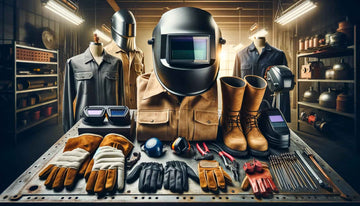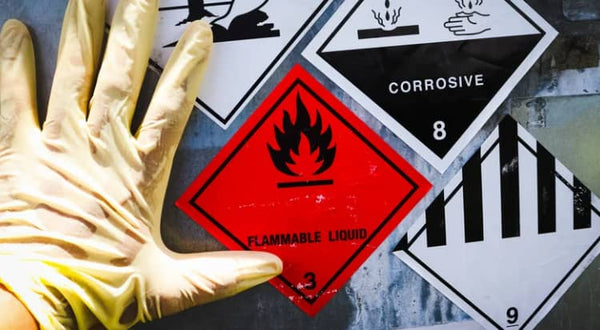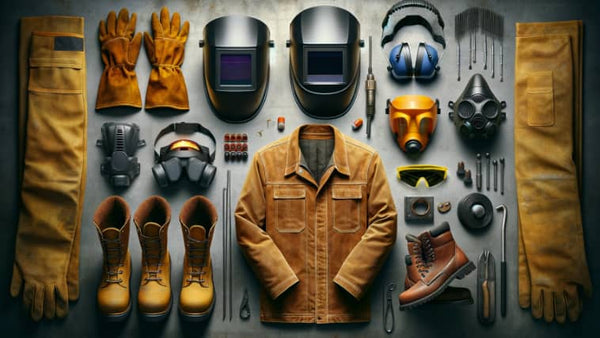
Using the right safety equipment in welding is important to protect yourself from hazards like electric shock, burns, and toxic fumes. Safety should always be a top priority on the job to ensure you're shielded from these risks.
Personal protective equipment (PPE) is essential for welding safety. This includes items such as welding helmets, gloves, eye protection, high-visibility clothing, safety footwear, and respiratory protective equipment.
Each piece of equipment serves a specific purpose in protecting you from the hazards of welding, and you should always wear the appropriate gear for the job at hand.
In this article, we'll take a closer look at each piece of equipment and why it's important for your safety on the job.
Understanding Welding Hazards

Welding can be a dangerous task that exposes you to a variety of health and safety hazards, including burns, ultraviolet radiation, fumes, and electrical shocks. Understanding these hazards is essential to protect yourself and others in your workspace.
1. Welding Burns
Welding burns are one of the most common injuries associated with welding. They can occur from direct contact with hot metal or from exposure to ultraviolet radiation.
To prevent burns, it is essential to wear appropriate protective clothing, such as leather gloves, long-sleeved shirts, and pants.
2. Ultraviolet Radiation
Ultraviolet radiation is another significant hazard in welding. It can cause damage to your skin and eyes, leading to conditions such as sunburn, cataracts, and even blindness.
To protect yourself from ultraviolet radiation, you should wear a welding helmet with a shaded lens and protective clothing that covers your skin.
3. Welding Fumes
Welding fumes can be harmful to your respiratory system, causing conditions such as metal fume fever, lung cancer, and other respiratory problems.
To protect yourself from welding fumes, you should use proper ventilation or wear a respirator.
4. Electrical Shocks in Welding
Electrical shocks are a severe risk for welders and can be fatal. To prevent electrical shocks, it is essential to ensure that your equipment is properly grounded and that you are wearing dry gloves and boots.
8 Types of Safety Equipment Used in Welding

Welding is a dangerous job that requires proper safety equipment to prevent injuries.
The following is an overview of the different types of safety equipment, including personal protective equipment (PPE) like helmets, gloves, aprons, and respirators.
1. Welding Helmets
Welding helmets are essential for protecting your eyes and face from the intense light and heat of welding. They are available in different styles, including auto-darkening helmets that adjust to the brightness of the welding arc automatically. Welding helmets must meet the ANSI Z87.1 safety standard.
2. Welding Gloves
Welding gloves are designed to protect your hands from heat, sparks, and spatter. They are made of heavy-duty materials and come in different types, including MIG gloves, TIG gloves, and stick welding gloves. Welding gloves must meet the ANSI Z49.1 safety standard.
3. Welding Aprons
Welding aprons are used to protect your body from sparks and spatter. They are made of leather or flame-resistant materials and come in different sizes and styles. Welding aprons must meet the ANSI Z49.1 safety standard.
4. Respirators
Respirators are used to protect your lungs from welding fumes and gases. They come in different types, including disposable respirators and air-purifying respirators. Respirators must meet the OSHA respiratory protection standard.
5. Safety Glasses
Safety glasses are used to protect your eyes from flying debris and particles. They are available in different styles and must meet the ANSI Z87.1 safety standard.
6. Welding Goggles
Welding goggles are similar to welding helmets but are smaller and cover only the eyes. They are typically used for low-amperage welding applications and provide a more comfortable fit for some welders.
7. Face shields
Face shields are another type of eye protection that can be used in welding. They cover the entire face and provide protection against flying debris, sparks, and chemical splashes.
Face shields are typically used in conjunction with other eye protection, such as goggles or a welding helmet with a flip-up visor.
8. Fire-resistant Jackets
These jackets are made of materials that are resistant to flames and heat. They protect your upper body from sparks, spatter, and heat. Fire-resistant jackets are available in different materials, including leather, cotton, and synthetic fabrics.
Protective Clothing for Welders
When it comes to welding, protective clothing is crucial to ensure your safety. Welding involves high temperatures, sparks, and spatter that can cause serious burns and injuries. Protective clothing is designed to protect you from these hazards and minimize the risk of injury.
Here are some of the necessary protective clothing for welders:
-
Fire-resistant jackets: These jackets are made of materials that are resistant to flames and heat. They protect your upper body from sparks, spatter, and heat. Fire-resistant jackets are available in different materials, including leather, cotton, and synthetic fabrics.
-
Gloves: Welding gloves are designed to protect your hands from heat, sparks, and spatter. They are made of materials that can withstand high temperatures. Welding gloves should fit snugly and cover your hands and wrists completely.
-
Aprons: Welding aprons protect your lower body from sparks, spatter, and heat. They are made of materials that are resistant to flames and heat. Welding aprons are available in different materials, including leather, cotton, and synthetic fabrics.
-
Boots: Welding boots protect your feet from sparks, spatter, and heat. They are made of materials that can withstand high temperatures. Welding boots should be made of leather or other fire-resistant materials and have a steel toe.
It is important to wear all of the necessary protective clothing when welding. This will help minimize the risk of injury and ensure your safety. Make sure that your protective clothing fits properly and is in good condition. If your protective clothing is damaged or worn out, replace it immediately.
Respiratory Protection in Welding

Welding is a process that generates fumes, gases, and metal oxides that can be harmful to your respiratory system. If you are exposed to welding fumes and gases for an extended period, you may suffer from respiratory irritation, asthma, lung cancer, and other severe health problems. Therefore, it is crucial to wear respiratory protection when welding to prevent inhalation of harmful fumes and gases.
There are different types of respirators that you can use when welding, depending on the level of protection you need. The most common respirators for welding are:
-
Disposable respirators: These are the most basic type of respirators that you can use when welding. They are designed to filter out large particles and are usually made of paper or cloth. They are cheap and easy to use but are not suitable for prolonged use.
-
Half-mask respirators: These respirators cover your nose and mouth and are designed to filter out smaller particles than disposable respirators. They are more expensive than disposable respirators but are more durable and can be used for extended periods.
-
Full-face respirators: These respirators cover your entire face and provide the highest level of protection. They are suitable for welding in confined spaces or when working with hazardous materials.
It is essential to choose the right respirator for the job and to wear it correctly. You should always follow the manufacturer's instructions when using a respirator and ensure that it fits snugly to your face. A poorly fitting respirator can allow fumes and gases to enter your respiratory system and cause harm.
Hearing Protection for Welders
When it comes to welding, hearing protection is crucial. Welding processes can produce high levels of noise that can cause hearing damage over time. That's why it's important to wear proper hearing protection when working in this field.
There are several options available for hearing protection in welding, including earmuffs and earplugs. Earmuffs are designed to cover the entire ear and provide a higher level of protection. They're also more comfortable to wear for extended periods of time. Earplugs, on the other hand, are inserted into the ear canal and provide a lower level of protection. They're also more discreet and easier to wear under a welding helmet.
Best Practices for Using Safety Equipment in Welding
Welding is a dangerous job that requires the use of proper safety equipment to prevent injuries. It's important to use and maintain your safety equipment properly to ensure maximum protection. Here are some best practices to follow:
Here are some best practices for using safety equipment in welding to ensure maximum protection and effectiveness:
- Wear Proper Welding Helmet: Always use an auto-darkening welding helmet to protect your eyes from intense light and your face from sparks and spatter.
- Use Flame-Resistant Clothing: Wear flame-resistant clothing such as a welding jacket, apron, or sleeves to protect against sparks, spatter, and heat.
- Select Appropriate Gloves: Use gloves that are specifically designed for welding, providing a good balance of heat resistance, dexterity, and durability.
- Ensure Good Ventilation: Always work in a well-ventilated area to avoid inhaling harmful fumes. Consider using a respirator if working in confined spaces or with particularly toxic materials.
- Protect Your Feet: Wear leather boots or shoes that are flame-resistant and cover your entire foot to protect against falling objects, sparks, and hot metal.
- Use Safety Glasses: Under the welding helmet, wear safety glasses with side shields to protect against flying particles and debris.
- Hear Protection: Use earplugs or earmuffs to protect your hearing, especially when working in environments with constant loud noise.
- Properly Maintain Equipment: Regularly inspect and maintain your safety gear to ensure it is in good condition and replace any worn or damaged items promptly.
- Follow Manufacturer’s Instructions: Always use safety equipment as directed by the manufacturer’s instructions to ensure it provides the intended level of protection.
- Stay Informed: Keep up-to-date with the latest safety standards and practices in the welding industry to continually enhance your safety measures.
Conclusion
In conclusion, welding safety equipment is an essential aspect of the profession, and it plays a crucial role in protecting welders from various hazards associated with their work. The right gear protects against numerous hazards inherent in this demanding craft, including burns, eye damage, respiratory issues, and hearing loss.
Welding helmets are a critical piece of safety equipment that protects the eyes and head from hot slag, sparks, intense light, and chemical burns. Welding gloves and proper attire also help mitigate risks associated with burns and other injuries.
Respiratory protection is also crucial when welding, as fumes and gases can be hazardous to your health. Respirators and ventilation systems can help protect you from inhaling dangerous substances.
In addition to the equipment mentioned above, there are also other safety measures you should take to ensure your safety while welding. These include maintaining a safe workspace, regular equipment maintenance, and ongoing training to stay up-to-date with the latest safety protocols.
Investing in quality welding safety equipment is investing in your well-being. By taking the necessary precautions and using the right gear, you can minimize the risks associated with welding and ensure that you stay safe on the job.
Frequently Asked Questions
What Are the Basic Safety Equipment?
The basic safety equipment for welding includes a welding helmet, fire-resistant gloves, protective clothing, and goggles. These items protect welders from heat, sparks, and harmful radiation. Welding safety gear also includes a respirator to protect against fumes and gases.
Why is Welding Safety Equipment Important?
Welding safety equipment is important because it protects welders from potential hazards. These hazards include electric shock, overexposure to fumes and gases, arc radiation, and fire and explosion. Welding safety equipment can also prevent eye injuries, skin burns, and respiratory problems.
What is the Purpose of Welding Equipment?
The purpose of welding equipment is to join two or more metal pieces together using heat, pressure, or a filler material. Welding equipment includes a welding machine, welding rods, welding wire, and a welding torch. Welding equipment is also used to cut and shape metal.
What is the Most Important Thing in Welding?
The most important thing in welding is safety. Welding can be a dangerous process, and it is important to take safety precautions to prevent injuries. This includes wearing the proper safety equipment, following safety procedures, and being aware of potential hazards.
What Are Three Safety Concerns to Be Aware of When Welding?
Three safety concerns to be aware of when welding are electric shock, fire and explosion, and overexposure to fumes and gases. Electric shock can occur if the welding machine is not properly grounded. Fire and explosion can occur if flammable materials are present. Overexposure to fumes and gases can cause respiratory problems.
